Total Lunar Eclipse (March 14, 2025)
There was a total lunar eclipse visible from the local area in the early morning hours of March 14, 2025. This was the first such event since the total lunar eclipse of November 8, 2022. We used the department’s SeeStar50 smart telescope to capture images of the event, through many clouds, from a dark sky observing site just west of Columbus, TX.
Unfortunately the weather was not as cooperative as we would have liked but it was still possible to get plenty of peaks and photos through the frequent breaks and openings in the clouds. This continued through totality but the clouds increased shortly after the end of totality and the sky was soon overcast, with only stray moonlight filtering through unbroken clouds.
The first image (below) was taken one minute before the Moon entered the penumbra, or outermost fringes of the Earth’s shadow. The next four showed the progressive shading darkening (along the bottom of the Moon) as the penumbral phase deepened. First contact with the umbra (the dark central shadow) of the Moon was at 5:09 UT. All mages © 2025 by Brian Cudnik.
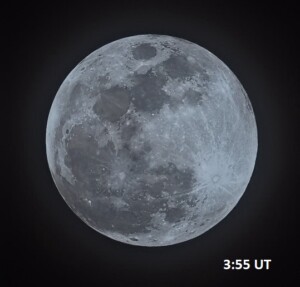 |
 |
 |
 |
 |
 |
 |
 |
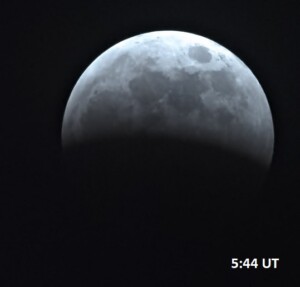 |
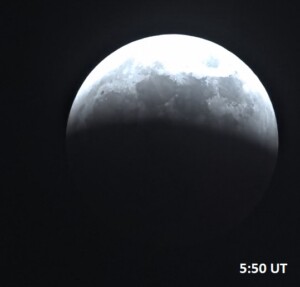 |
 |
 |
As the partial eclipse progressed, the part of the Moon in shadow usually becomes visible as a faint glow minutes after umbral contact. However, this visibility was hindered due to high cirrus clouds that were present all evening but were slow to clear. As these cleared, the low stratocumulus began to come up from the south and provided an almost continuously varying view. It was only during the clearest moments, and when the partial eclipse became deeper, that the shadowed part of the Moon became visible (the bottom three images above).
The next six images show the transition from partial to total eclipse. Totality began at 6:26 UT, so the Moon is shown in mage form some four minutes before and three minutes after second contact. The top (northern) part of the Moon was brighter than the rest throughout the event, with this bright “cap” slowly rotating counterclockwise as the Moon slid through the umbral shadow. The middle part of the eclipse, when the Moon is deepest into the Earth’s umbra, was at 6:59 UT.
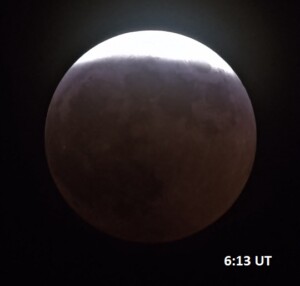 |
 |
 |
 |
 |
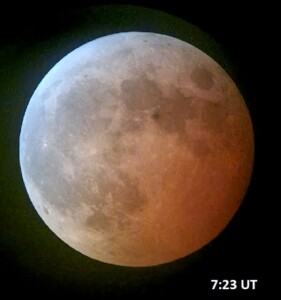 |
The image above and right was made using a different imaging technique: a camera held at the low power eyepiece of a 14-inch Cassegrain telescope. This shows more realistically how the eclipse appeared visually. The blue along the upper left part of the Moon is referred to as “the Ozone Fringe” where light passing through the ozone layer is sorted so that the reds and oranges are scattered away, allowing the blues and violets through. This is opposite to what usually happens at sunset and sunrise on Earth’s surface. The 65 minute totality came to an end at 7:31 UT. The last images below, particularly the ones taken at 7:56 and 8:07 UT, were taken when the breaks in the clouds were becoming shorter-lived, making it much more difficult to get a proper alignment for a picture. Partial eclipse ended (behind a solid deck of clouds) at 8:47 UT; the eclipse was completely over at 10:00 UT, when the Moon exited the penumbra. This otherwise unobservable event happened behind a solid deck of clouds.
 |
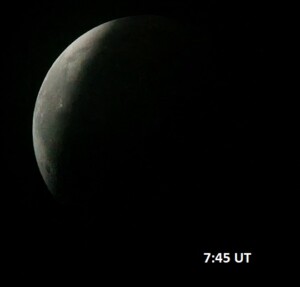 |
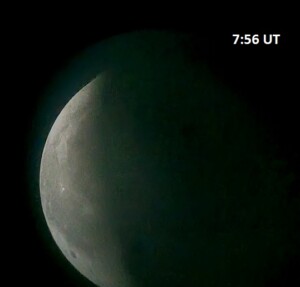 |
The next total lunar eclipse happens on September 7, 2025, but it is not visible from the Americas. This event will be seen in eastern Europe, Asia, India, and Australia. The next total lunar eclipse visible from this part of the world (Texas) will happen on March 3, 2026, a 58-minute long total eclipse.
———————————————————————————–

